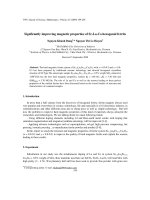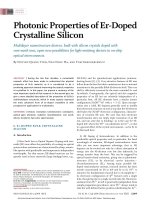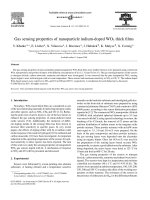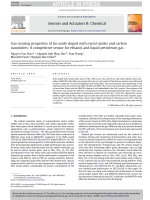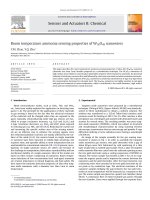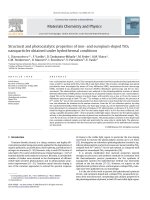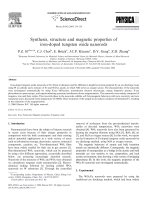- Trang chủ >>
- Khoa Học Tự Nhiên >>
- Vật lý
High temperature electric properties of polycrystalline la doped camno3 ceramics
Bạn đang xem bản rút gọn của tài liệu. Xem và tải ngay bản đầy đủ của tài liệu tại đây (839.29 KB, 4 trang )
J. Mater. Sci. Technol., Vol.25 No.4, 2009
535
High-temperature Electric Properties of Polycrystalline
La-doped CaMnO3 Ceramics
Jinle Lan1) , Yuanhua Lin1)† , Ao Mei1) , Cewen Nan1)† , Yong Liu2) , Boping Zhang2)
and Jingfeng Li1)
1) State Key Laboratory of New Ceramics and Fine Processing, Department of Materials Science and Engineering,
Tsinghua University, Beijing 100084, China
2) School of Materials Science and Engineering, University of Science and Technology Beijing, Beijing 100083, China
[Manuscript received June 30, 2008, in revised form January 20, 2009]
Polycrystalline La-doped CaMnO3 ceramics have been prepared by a solid-state sintering method. Analysis
of microstructure and phase composition indicates that the addition of La can prohibit the further growth of
grain, and no impurity phase appears. The results revealed that the La doping can lead to a large change of
the activation energy (from 0.22 to 0.02 eV), and thus result in a marked increase in electric conductivity of
2–4 orders of magnitude. The power factor can reach about 1.5×10−4 W·m−1 ·K−2 in a wide temperature
range, which potentially make them attractive for n-type high-temperature thermoelectric materials.
KEY WORDS: CaMnO3 ; Thermoelectric; Activation energy; Seebeck coefficient
1. Introduction
Thermoelectric material can directly convert heat
into electric energy and vice versa through the thermoelectric phenomena in solids, which make it a
potential way for clean energy generation by transforming the heat into electricity[1] . Normally, as for
the thermoelectric materials, the conversion efficiency
can be well characterized by the dimensionless figure
ZT =S 2 σT /κ (where T , S, σ, and κ are the absolute
temperature, thermoelectric power, electrical conductivity, and thermal conductivity, respectively). Therefore, high electrical conductivity σ, large Seebeck coefficient S, and low thermal conductivity κ are highly
expected for practical development of thermoelectric
materials and related devices[2] .
As for the conventional non-oxides materials (e.g.,
Bi-Te, Bi-Se system)[3] , there exist some shortcomings such as surface oxidation and vaporization at
high temperature, and limit further applications of
these materials. Oxides, owing to their low thermal conductivity and high-resistance of oxidation at
high temperature, have recently attracted considerable attention. Recently, oxides-based thermoelectric materials have been explored (e.g., SrTiO3 , NiO,
TiO2 )[4–6] . Some CoO2 -based oxides with layered
structures (e.g., Ca3 Co4 O9 ) have been reported to
show good p-type thermoelectric properties at high
temperature in air[7,8] , the much-needed corresponding n-type oxides with good thermoelectric properties for power generation are still a challenge for
high thermoelectric performance. Some previous
studies on the CaMnO3 perovskite system suggested
that CaMnO3 could be a potential candidate as an
n-type thermoelectric material[9,10] . As we know,
CaMnO3 is an electron-doped compound, which belongs to the perovskite structure with a=0.5278 nm,
b=0.7448 nm, and c=0.5268 nm. Some previous studies indicated that the CaMnO3 perovskite system
can exhibit colossal magnetoresistance properties at
† Corresponding author. Tel.: + 86 10 62773741; E-mail address: (Y.H. Lin);
(C.W. Nan).
low temperature[11] . Funahash et al.[12] have investigated the structure and thermoelectric properties
of polycrystalline samples Ca1−x Ax MnO3 (A=Yb,
Tb, Nd, and Ho), and reported that the Ybsubstituted CaMnO3 showed good thermoelectric
properties (ZT ≈0.16 at 1000 K).
Although electron-doped CaMnO3 as a member
of the large family of perovskite oxides has been suggested to be potential n-type thermoelectric materials, up to now, only a few systematical studies on
the high-temperature thermoelectric properties have
been reported. In this work, we fabricated La-doped
CaMnO3 -based ceramics, and reported the effect of
La substitution on the phase composition, microstructure and high-temperature thermoelectric properties.
2. Experimental
Polycrystalline ceramic samples of Ca1−x Lax MnO3
(x=0, 0.02, 0.04, 0.06, 0.08) were synthesized via a
conventional solid-state reaction. Analytical purity
CaCO3 , MnCO3 , and La2 O3 were used as raw materials, which were weighted in stoichiometric ratio
and mixed by ball mill for 24 h, and then the mixed
powders were pre-calcined at 1373 K for 6 h. Finally, La-doped CaMnO3 ceramics can be obtained
by sintering at 1473 K for 10 h.
X-ray diffraction (XRD) with a Rigaku D/MAX2550V diffractometer (CuKα radiation) and scanning
electron microscopy (SEM) were employed to reveal
the microstructure and phase composition of the assintered Ca1−x Lax MnO3 ceramic samples. The samples for the measurements of thermoelectric properties were cut out of the sintered bodies in the form
of rectangular bars of 4 mm×4 mm×20 mm with a
diamond saw, and silver paint electrodes were formed
on both sides of the sintered ceramic discs for electrical measurements. The temperature dependence of
electric conductivity was measured in the temperature range from room temperature to 800◦ C by fourprobe method. Thermoelectric power was obtained
from the slope of the linear relation between ∆V and
∆T , where ∆V is the thermoelectromotive force pro-
536
(d)
(c)
(b)
(a)
30
40
50
60
Lattice constants / A
(422)
(220)
(e)
20
a
b
c
7.465
(211)
(022)
Intensity / a.u.
(110)
(112)
J. Mater. Sci. Technol., Vol.25 No.4, 2009
7.460
5.32
5.30
5.28
5.26
70
0.00
2
/ deg.
Fig. 1 XRD patterns of as-sintered samples:
(a) CaMnO3 , (b) Ca0.98 La0.02 MnO3 ,
(c) Ca0.96 La0.04 MnO3 , (d) Ca0.94 La0.06 MnO3 ,
(e) Ca0.92 La0.08 MnO3
duced by temperature difference ∆T .
3. Results and Discussion
The XRD patterns shown in Fig. 1 indicate that
all the samples are single phase CaMnO3 with an orthorhombic perovskite-type structure (ICSD#82211).
No impurity phase can be observed in these ceramic samples, which reveals that La ions can replace the Ca sites. The substitution of the Ca
sites with trivalent La ions will lead to the variation of electric properties, and the detailed results
will be given in the following content. Figure 2
shows the lattice parameters a, b and c as a function for the changes with La doping. The parameters a, b and c all increase monotonously. This result
0.02
0.04
La content,
0.06
0.08
x / mol
Fig. 2 Lattice parameters of the Ca1−x Lax MnO3 series
as a function of La substitution content
can be well understood based on the fact that the
ionic radius of La3+ is larger than that of Ca2+ .
Figure 3 shows the SEM images of the surface
of the as-sintered La-doped CaMnO3 samples. Obviously, in pure CaMnO3 ceramic sample, the grain
size is about 3–5 µm, and larger than that in the
La-doped samples, which indicates that the addition
of La can act as the grain growth inhibitor and prohibit the further growth of CaMnO3 grain. The similar behavior has also been observed in the La-doped
Na0.5 Bi0.5 TiO3 ceramic samples[13] . It can be observed that the samples sintered at 1473 K have small
pores, and these pores can reduce the thermal conductivity, which can improve thermoelectric properties.
The effect of the pores will be investigated in future
work.
Figure 4 gives the temperature dependence of electrical conductivity of these La-doped CaMnO3 samples in the temperature range from room tempera-
Fig. 3 SEM images of the surface of as-sintered samples: (a) CaMnO3 , (b) Ca0.96 La0.04 MnO3 ,
(c) Ca0.94 La0.06 MnO3 , (d) Ca0.92 La0.08 MnO3
537
J. Mater. Sci. Technol., Vol.25 No.4, 2009
0
(a)
120
(b)
100
(d)
Seebeck / ( v/K)
-
-100
(c)
(e)
1
/ (S cm )
140
80
60
40
20
-300
(a)
-400
(b)
(c)
(d)
-500
(e)
0
300
-200
400
500
600
700
T/K
800
-600
300
900 1000 1100
400
3.0
W/mK )
2
(b)
(c)
2.0
1.5
Power factor / (10
2.5
-4
(e)
Activation energy / eV
K)
-1
T) / (S cm
Lg (
(d)
3.0
800
900
1000 1100
(a)
(a)
3.5
700
Fig. 6 Temperature dependence of the Seebeck coefficient for: (a) CaMnO3 , (b) Ca0.98 La0.02 MnO3 ,
(c) Ca0.96 La0.04 MnO3 , (d) Ca0.94 La0.06 MnO3 ,
(e) Ca0.92 La0.08 MnO3
5.0
4.0
600
T/K
Fig. 4 Electrical conductivity as a function of temperature for: (a) CaMnO3 , (b) Ca0.98 La0.02 MnO3 ,
(c) Ca0.96 La0.04 MnO3 , (d) Ca0.94 La0.06 MnO3 ,
(e) Ca0.92 La0.08 MnO3
4.5
500
0.20
0.15
0.10
0.05
(b)
2.5
(c)
(d)
2.0
(e)
1.5
1.0
0.5
0.00
0.00
1.0
0.02
0.04
0.06
0.08
0.10
0.0
x / mol
300
0.5
1.0
1.5
2.0
(1000/
2.5
3.0
3.5
500
600
700
800
900
1000 1100
T/K
4.0
T) / (1/K)
Fig. 5 lg(σT ) vs 1000/T plots for: (a) CaMnO3 ,
(b) Ca0.98 La0.02 MnO3 , (c) Ca0.96 La0.04 MnO3 ,
(d) Ca0.94 La0.06 MnO3 , (e) Ca0.92 La0.08 MnO3
ture to 1075 K. The undoped CaMnO3 is a typical
n-type semiconductor, and shows a low conductivity (∼0.02 S/cm) at room temperature. However,
the La doping, even as low as x=0.02, can cause a
marked increase in conductivity of 2–3 orders of magnitude, especially when x=0.08 (∼100 S/cm), and the
value changes slightly with increasing the temperature. This similar electrical behavior has also been
observed in the low Pr-doped CaMnO3 ceramics[14] ,
which may be ascribed to the variation of the strength
of the bending of the Mn–O–Mn bond and narrowing
the conduction bandwidth.
For the interpretation of conducting phenomenon
in Mn-based perovskite system, the temperature dependence of the conductivity is generally described
using the small polaron model given by Mott and
Davis[15] as follows,
σ = (C/T )exp(−Ea /KB T )
400
(1)
where C, Ea , KB , and T are the pre-exponential terms
related to the scattering mechanism, the activation
energy, Boltzmann constant, and absolute temperature, respectively.
Figure 5 illustrates the plots of lg(σT ) vs 1/T
for various La-doped samples. Obviously, when the
temperature is below 600 K, all samples show a good
linearity between lg(σT ) and 1/T . Additionally, for
La-doped CaMnO3 sample, this linear behavior can
Fig. 7 Temperature dependence of the power factor for: (a) CaMnO3 , (b) Ca0.98 La0.02 MnO3 ,
(c) Ca0.96 La0.04 MnO3 , (d) Ca0.94 La0.06 MnO3 ,
(e) Ca0.92 La0.08 MnO3
be retained at higher temperature as the La-doping
concentration increases. The activation energy Ea obtained from Eq. (1) (insert in Fig. 5) for pure CaMnO3
is about 0.22 eV, which is in agreement with that reported in previous work (0.16 eV)[16] . Moreover, for
La-doped CaMnO3 samples, they yield smaller activation energies of ∼0.02–0.03 eV, which was also
observed in Ce3+ -, Y3+ -, or Sm3+ -doped CaMnO3
samples (∼0.02–0.04 eV)[16] . The variation of activation energy should be attributed to the doping effect
of trivalent La ions on the Ca sites and the related
hopping conduction mechanism in the CaMnO3 -based
perovskite oxides. To understand the nature of the
conduction behavior in this system, further investigation is necessary and desirable.
Figure 6 shows the temperature dependence of S
for the La doped CaMnO3 samples. The S values are
all negative, indicating n-type conduction. The pure
CaMnO3 sample shows a large absolute value of S
(∼550 µV/K at near 500 K), and decreases with increasing the temperature, which should be related to
the carrier concentration and semiconductor behavior.
For these La-doped CaMnO3 samples, with the temperature increasing (from RT to 450 K), the absolute
S values also increase. It may be ascribed to the variation of Mn2+ /Mn3+ . These various valence states
of Mn ions will give contribution on the Seebeck coefficients like Co2+ /Co3+ in the CoO2 -based layered
oxides as previously reported[7,8] . As the tempera-
538
J. Mater. Sci. Technol., Vol.25 No.4, 2009
ture further increases, the absolute S values intend to
decrease, which may be mainly related to the variation of the corresponding electrical conductivity, and
need further work to understand these behaviors. It
should be pointed out that though the S decrease, a
maximum power factor S 2 σ=1.5×10−4 W·m−1 ·K−2
appears for the La-doped sample with x=0.04 in a
wide temperature range (see Fig. 7), being ascribed
to the improvement in the electric conductivity.
As shown in Fig. 7, the power factors Sσ 2 calculated from the electric conductivity and Seebeck coefficient indicate that the La substitution has a great
influence on the power factor, which should be caused
by the significant variation of the electric conductivity and Seebeck coefficient, which can be comparable
to the other n-type La, Y, or Dy doped SrTiO3 and
Al and Ti co-doped ZnO ceramic systems[17,18] . The
good thermoelectric performance and high temperature durability in air suggest that these oxides can be
potential high temperature thermoelectric materials.
4. Conclusion
We fabricated polycrystalline La-doped CaMnO3
ceramics by the conventional solid state reaction, and
investigated the effect of La substitution on the hightemperature thermoelectric properties. Our results
indicate that all La-doped CaMnO3 samples show
negative Seebeck coefficients, indicating n-type conduction. The La doping has a remarkable effect on
the electric transport properties of these CaMnO3 based ceramics, which may be related to the carrier
concentration, defect structure, the spin-state of the
electrons caused by the La3+ ions on the Ca2+ sites.
Acknowledgements
This work was financially supported by the National
Program on Key Basic Research Project (“973 Program”)
under grant No. 2007CB607505, and the National High
Technology Research and Development Program of China
under grant No. 2009AAO3Z216.
REFERENCES
[1 ] D.M. Rowe: CRC Handbook of Thermoelectrics,
CRC, Boca Raton, FL, 1995.
[2 ] G. Chen, M.S. Dresselhaus, G. Dresselhaus, J.P. Fleurial and T. Caillat: Int. Mater. Rev., 2003, 48, 1.
[3 ] M. Ito, W.S. Seo and K. Koumoto: J. Mater. Res.,
1999, 14, 209.
[4 ] S. Ohta, T. Nomura and H. Ohta: Appl. Phys. Lett.,
2005, 87, 092108.
[5 ] W. Shin and N. Murayama: Jpn. J. Appl. Phys.,
1999, 38, L1336.
[6 ] D. Kurita, S. Ohta, K. Sugiura, H. Ohta and K.
Koumoto: J. Appl. Phys., 2006, 100, 096105.
[7 ] I. Terasaki, Y. Sasago and K. Uchinokura: Phys. Rev.
B, 1997, 56, R12685.
[8 ] Y.H. Lin, C.W. Nan, Y.H. Liu, J.F. Li, T. Mizokawa
and Z. Shen: J. Am. Ceram. Soc., 2007, 90, 132.
[9 ] L. Sudheendra, A.R. Raju and C.N. Rao: J. Phys.Condens. Mat., 2003, 15, 895.
[10] G. Xu, R. Funahashi, Q. Pu, B. Liu, R. Tao, G. Wang
and Z. Ding: Solid State Ionics, 2004, 171, 147.
[11] A. Maignan, C. Martin, F. Damay and B. Raveau:
Chem. Mater., 1998, 10, 950.
[12] D. Flahaut, T. Mihara, R. Funahashi, N. Nabeshima,
K. Lee, H. Ohta and K. Koumoto: J. Appl. Phys.,
2006, 100, 084911.
[13] H. Aree and S. Ahmad: J. Am. Ceram. Soc., 1997,
80, 2954.
[14] B. Cong, T. Tsuji, P. Thao, P. Thanh and Y. Yamamura: Physica B, 2004, 352, 18.
[15] N. F. Mott and E. A. Davis: Electronic Processes in
Non-crystalline Materials, Clarendon Press, Oxford,
1971.
[16] M. Ohtaki, H. Koga, T. Tokunaga, K. Eguchi and H.
Arai: J. Solid State Chem., 1995, 120, 105.
[17] H. Muta, K. Kurosaki and S. Yamanaka: J. Alloy.
Compd., 2003, 350, 292.
[18] K. Park, K. Y. Ko, W. S. Seo, W. S. Cho, J. G. Kim
and J. Y. Kim: J. Eur. Ceram. Soc., 2007, 27, 813.
